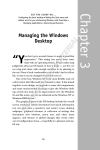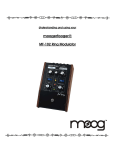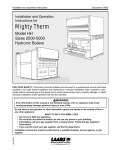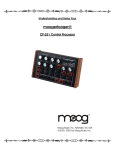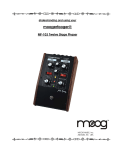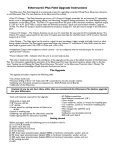Download Moog MF-104Z Specifications
Transcript
Understanding and Using Your moogerfooger® MF-104Z ANALOG DELAY 1 Welcome to the world of moogerfooger® Analog Effects Modules. Your Model MF-104Z Analog Delay is a rugged, professional-quality instrument, designed to be equally at home on stage or in the studio. Its great sound and smooth player controls come from its state-of-theart analog circuitry, designed and built under Bob Moog's personal direction. Your MF-104ZAnalog Delay features an all-analog delay circuit with delay times from 50 milliseconds to 1000 milliseconds. Its finely tuned frequency response and overload contours produce the sound quality of the best classic vintage delay devices. Each of the three performance parameters may be controlled smoothly and continuously by panel knob, expression pedal, or external control voltage. Audio input and output signals may be set to any instrument or line level. Housed in a rugged steel and hardwood enclosure, the MF-104Z, like other moogerfooger instruments, has the classic good looks, versatility, and high sound quality of the well-known vintage MOOG synthesizers. The following pages will first tell you how to hook up your MF104Z and set the panel controls for the ‘basic’ setup. Next, we'll explain how your MF-104Z works. After that we'll go through the panel features and give you suggestions on how to use your MF-104Z in some specific applications. At the end of this booklet, you'll find technical specifications, service, and warranty information, and information about Moog Music. CONTENTS GETTING STARTED - - - - - - - - - - - - - - - - - - 3 WHAT IS AN ANALOG DELAY? - - - - - - - - - - - - 6 PERFORMANCE PARAMETER CONTROLS - - - - - - 7 THE WHITE SWITCHES - - - - - - - - - - - - - - - - - 8 THE AUDIO LEVEL CONTROLS - - - - - - - - - - - - 9 AUDIO OUTPUTS; EXPRESSION PEDALS - - - - - - - 11 TYPICAL SETUPS - - - - - - - - - - - - - - - - - - —- 12 TECHNICAL INFORMATION - - - - - - - - - - - - - 17 WARRANTY INFORMATION - - - - - - - - - - - - - 21 2 SPECIFICATIONS - - - - - - - - - - - - - - - - - - - 22 GETTING STARTED Here are simple instructions on how you can quickly plug in and try out your MF-104Z. 1. Unpack your MF-104Z. You can place it on a table or on a floor. We suggest that you place it on a table while you become familiar with its features. 2. Check that the power adapter has a nominal rating of +9 volts and is also rated at your country's standard power voltage (120 volts A.C. for the United States and Canada, 100 volts A.C. for Japan, and 220 volts A.C. for most other countries). Plug the power adapter's cord into the MF-104SD's `+9V' jack. Then plug the power adapter itself into a power voltage receptacle. (See Page 19 for more detailed technical information on power adapters for the MF-104Z.) 3. Note that the BYPASS light is on. It will light up either red or green. Red indicates that the MF-104Z’s delay circuit is off-line (bypassed), while the green indicates that the delay circuit is on-line. Pressing the `stomp switch' will toggle the BYPASS light between red and green. For now, leave the BYPASS light on red. Refer to Figure 1 for steps 4. and 5. 4. Connect an instrument cable from the MIX OUT Figure 1 - Basic connections: Instrument to jack to a line-level input AUDIO IN, monitor amp to MIX OUT, and power adapter to +9V. on your amp or mixer. 3 Turn the volume control on your amp down but not off. 5. Connect an instrument cable from your signal source to the AUDIO IN jack. You can feed virtually any instrument-level or line-level signal through your MF-104Z. Examples are guitar, bass, keyboard, theremin, drum machine, or Effects Send output on your mixer. Refer to Figure 2 for step 6. 6. Set the MF-104Z panel controls as follows. MIX 0 DELAY TIME 0.3 FEEDBACK 0 LOOP GAIN 0 DRIVE fully counterclockwise OUTPUT LEVEL fully counterclockwise Left Switch SHORT Right Switch INT. LOOP Play your instrument (or turn on the signal source). Adjust the volume control on your monitor amp so that the sound level is comfortable. Now set the DRIVE and OUTPUT Figure 2 - Basic settings for becoming LEVEL controls exactly as familiar with your MF-104Z. described in steps 7. and 8. 7. Press the stomp switch so the BYPASS light goes green. Playing your instrument, set the DRIVE control so the INPUT LEVEL indicator lights up green-yellow or redyellow most of the time, and becomes bright red only on occasional peaks. 8. Set the OUTPUT LEVEL control so that there is no loudness change when the BYPASS light goes back and forth between green and red. Once the DRIVE and OUTPUT LEVEL controls are set, you should not change them unless you change the loudness of your signal source. 4 9. Switch the BYPASS light to green. Continuing to play your instrument, turn the MIX control clockwise. When the MIX control is at 0, you will hear just the direct (undelayed) signal. When the MIX control is at 5 (midposition), you will hear both the direct and delayed signal. When the MIX control is at 10, you will hear just the delayed signal. Note that the delayed signal has a softer, more muted quality than the direct signal, - just as natural echoes are softer and more muted than direct sounds. 10. Set the MIX control to 5, so you hear both the direct and delayed signals. Vary the setting of the DELAY TIME control. When the control is fully counterclockwise, the delay is very short, - about 50 milliseconds. (A millisecond is a thousandth of a second.) When the control is fully clockwise, the delay is about 500 milliseconds. Note that when you turn the DELAY TIME control while you're playing, the pitch will change briefly. This is because turning the DELAY TIME control causes your sound to stretch or compress as it goes through the delay circuit, thereby speeding up or slowing down the vibrations. 11. Set the left switch to LONG. This doubles the delay time. It also imparts an even more muted quality to the delayed signal. Experiment with various settings of the DELAY TIME control and the SHORT-LONG switch to get a feeling for how they affect the delayed signal. 12. Return the left switch to SHORT and the DELAY TIME control to midposition. Turn the FEEDBACK control slowly clockwise. You will now hear a series of echoes of each sound that you play. The FEEDBACK control creates the series of echoes by mixing a portion of the delayed signal with the signal from your instrument. When the FEEDBACK control is set to about 8, the echoes sustain indefinitely. With the FEEDBACK control above 8, the echoes build up chaotically into some amazing electronic textures. In the next sections we'll explain how an analog delay works and look at your MF-104Z in more detail. For now, get a feel for your MF104Z's controls by experimenting with different settings. 5 WHAT IS AN ANALOG DELAY? A delay circuit produces a replica of an audio signal a short time after the original signal is received. If you listen to the original (direct) signal and the delayed signal together, the delayed signal will sound like an echo of the direct. To make a whole series of echoes that die out gradually, you feed the delayed output signal back to the input. You can determine how far apart the echoes are by adjusting the delay time of the delay circuit, and you can adjust how fast the echoes die out by adjusting the amount of feedback from the delay circuit output to its input. In addition, you can determine how loud the echoes are by adjusting the mix between the direct signal and the delayed signal. Today there are three types of delay devices: tape, analog, and digital. The first delay devices used magnetic tape to create the delay. The sound was recorded on a moving tape, and then played back after the tape had moved a few inches or so. Then, during the early `70's, large-scale semiconductor analog delay circuits became available. These were called bucket brigade delay chips, because they functioned by passing the audio waveform down a chain of several thousand circuit cells, in analogy to water being passed by a bucket brigade to put out a fire. Each cell in the chip introduces a tiny delay. The total time delay depends on the number of cells and on how fast the waveform is `clocked', or moved from one cell to the next. Analog delays were less noisy, easier to use, and more reliable than tape echo units, and came to be more widely used. More recently, digital delay units have come into use. In a digital delay unit, the sound signal is first converted to numbers. The numbers are stored in a digital memory for a certain time, and then retrieved and reconstructed into the delayed audio waveform. One significant difference between analog and digital delay units is that the particular frequency and overload contours of well-designed analog devices generally provide smoother, more natural series of echoes than digital delay units. Another difference is that the echoes of a digital delay are static because they are the same sound repeated over and over, whereas a bucket brigade device itself imparts a warm, organically evolving timbre to the echoes. The design of your MF-104Z Analog Delay is unique because it combines authentic, finely-tuned vintage analog bucket-brigade delay circuitry with analog-synthesizer-style voltage control of delay time, feedback, and direct/delay mix. 6 PERFORMANCE PARAMETER CONTROLS Performance parameters are controls that are meant to be played during performance. Each of the MF-104Z's performance parameters is controlled both by a front panel knob and by a pedal/control jack on the rear panel. The parameters are MIX, DELAY TIME, and FEEDBACK.. MIX control: As you turn the MIX knob clockwise from 0 to 5, the delayed signal becomes louder while the direct signal remains at maximum volume. Then, as you turn the MIX knob from 5 to 10, the delayed signal remains at maximum volume while the direct signal decreases to silence. This characteristic gives a natural-sounding mix for most music signals. If you're applying a sustained steady pitch to the MF-104Z and the MIX control is set near midposition, you may find that the direct and delayed signals alternately reinforce and cancel each other in rapid succession as the delay time is varied. This is a normal result of mixing a steady pitch with a delayed replica of itself. It is the analogdelay equivalent of `standing waves' in a reverberant room. DELAY TIME control: With the SHORT/LONG switch set on SHORT, the delay time will vary from 50 milliseconds to 500 milliseconds as the DELAY TIME knob is turned clockwise. Note that the knob is calibrated directly in time (seconds). With the SHORT/LONG switch set on LONG, the DELAY TIME knob will vary the delay time from 100 milliseconds to 1000 milliseconds. FEEDBACK control: There is no feedback when the FEEDBACK knob is on 0. The feedback increases as you turn the knob clockwise. When the knob is around 8, the Figure 3 - MF-104Z Front Panel. echoes will sustain indefinitely for 7 most delay time settings. With the FEEDBACK knob turned clockwise past 8, the echoes will grow in amplitude until they reach the overload point of the delay circuitry. In addition, the background noise will also build up and compete with the delayed signal. When you switch your MF-104Z into BYPASS, the feedback loop will shut down and the echo stream will die out within less than a second. Then, when you switch your MF-104Z on again, a new echo stream will begin to build up. This is a convenient way of `canceling' an echo stream while you're playing. THE WHITE SWITCHES The SHORT-LONG switch works with the DELAY TIME control. The delay time range is 50 milliseconds to 500milliseconds when the switch is on SHORT, and 100 to 1000 milliseconds when the switch is on LONG. In addition, the frequency response of the delay circuit is more restricted when the switch is on LONG than it is when the switch is on SHORT. The INT.LOOP-EXT.LOOP switch selects the feedback path. When this switch is in INT.LOOP, the feedback path goes directly from the output of the delay circuit back to the input. When this switch is in EXT.LOOP, the feedback loop goes through the LOOP OUT jack and the LOOP IN jack. This provides you with an opportunity to insert a signal processor of your choice in the feedback path, thereby enabling you to process the echoes as they're being generated. The LOOP GAIN knob affects only the external loop, and has no effect whatsoever when the switch is set on INT.LOOP. Detailed information on using the external loop and setting the LOOP GAIN knob is given in the next two sections. 8 THE AUDIO LEVEL CONTROLS The DRIVE control adjusts the signal level at the delay circuit input. With this control you can set the right input level for virtually any instrument or line-level signal source. Turn this control counterclockwise for strong signal inputs, and clockwise for weaker sound sources. The INPUT LEVEL light tells how strong the input signal is after being adjusted by the DRIVE control. As the signal level increases, the light goes from dark, to pale green, to bright green, to yellow-green, to yellow-red, to bright red. When the light is green, the signal is below the level that results in audible distortion. When the light is yellow, some low order distortion may be audible, giving the sound a warm analog quality. When the signal is strong enough to drive the light into the red, the distortion at the output becomes more distinctly audible. There are two factors which you should keep in mind when adjusting the DRIVE control. 1.The bypass signal is a faithful replica of your instrument signal, but is buffered by the audio input circuit. As a result, if the DRIVE control is turned up to where the INPUT LEVEL light stays red when you play, the bypass signal may be audibly distorted. You can avoid distortion of the bypass signal by adjusting the DRIVE control so that the INPUT LEVEL indicator generally stays in the green and yellow region, and goes red only on the loudest peaks. 2. The DRIVE control should be set while the BYPASS indicator is green. When you switch the BYPASS indicator from green to red, you may see the INPUT LEVEL indicator change color slightly. This is a normal feature of the MF-104Z audio input circuitry. Once you set the DRIVE control as described above, the input level is optimized for best operation of your MF-104Z's circuitry. Do not change the DRIVE setting except to tweak the input level or to compensate for changes in the level of your instrument signal. The OUTPUT LEVEL control adjusts the levels of the direct and delayed signals that appear at the MIX OUT and DELAY OUT jacks. This control does not affect the level of the bypassed signal, and it does not affect the level of the signal that appears at the LOOP OUT 9 jack. You should adjust the OUTPUT LEVEL after you set the DRIVE control. Set the OUTPUT LEVEL control so that you get the desired balance between on-line and bypass signals when you toggle the stomp switch. The LOOP GAIN control adjusts the signal level which is applied to the LOOP IN jack. You use this control to set the right loop gain for the external sound processing device that you connect between the LOOP OUT jack and the LOOP IN jack. Connect the external sound processor and set the LOOP GAIN control as follows: 1. Use patch cords to connect a) the MF-104Z LOOP OUT jack to the Audio In (instrument) jack on your processor, and b) the Audio Out (amplifier) jack on your processor to the MF-104Z LOOP IN jack. 2. Turn the external processor on. Playing your instrument, set your processor's Drive or Input Level control for proper operation of the processor. 3. Set your processor's Output Level control (if it has one) to balance your processor's bypass signal with its on-line signal. 4. Finally, set your MF-104Z's LOOP GAIN control so the LOOP LEVEL light is green-yellow or yellow-red most of the time that you are playing, and flashes red only briefly on loudness peaks. An alternate way of setting up the gain of the external feedback loop is a) to temporarily connect your external processor's output directly to your amplifier instead of to the MF-104Z's LOOP IN jack, then b) perform steps 2. and 3. as written above, c) connect your Figure 4 - The MF-104Z’s jack panel. external processor's output to the MF-104Z’s LOOP IN jack and d) perform step 4. This may be somewhat easier for some types of processing devices. Note again that the LOOP GAIN control and the LOOP LEVEL light have no effect when the feedback mode switch is on INT.LOOP. 10 An example of a setup using the MF-104Z's EXT.LOOP mode is "NEPTUNE'S CANYON", which is given on page 15. AUDIO OUTPUTS Your MF-104Z has two audio output jacks: DELAY OUT and MIX OUT. When the unit is on-line, the DELAY OUT jack delivers just the signal that actually goes through the delay circuit, and the MIX OUT jack delivers both direct and delayed signals in the proportion determined by the MIX control. When the unit is in bypass mode, both jacks deliver just the bypass signal. EXPRESSION PEDALS AND VOLTAGE CONTROL You now know what each of the control knobs does to the sound of the MF-104Z. Each of the three performance parameters, MIX, TIME, and FEEDBACK, has an expression pedal/control input which duplicates its effect. This enables you to plug in up to three expression pedals to play the MF-104Z with your feet as well as your hands. The moogerfooger EP-1 Expression Pedal is designed for this purpose or you can use expression pedals with equivalent specifications. See the Technical Information section on Page 19 for more information on pedal specifications. When you plug an expression pedal into one of the pedal inputs on your MF-104Z, the pedal adds to the effect of the corresponding control. For example, let's say that you plug an expression pedal into your MF-104Z's MIX input. With the pedal all the way back, the direct-delay mix is set by the MIX knob. Then, as you advance the pedal, the delay signal increases, just as if you turned the MIX knob up. A good rule to follow is: when you use the expression pedal, set the corresponding knob for the lowest value you want. Advancing the pedal increases that value. The MIX, TIME, and FEEDBACK jacks can also be used as control signal inputs. This enables you to use your MF-104Z with virtually 11 any control signal source: modular analog synthesizers, MIDI-to-CV converters, etc. You will find examples of interfacing your MF-104Z with external control signals on Pages 19-20, and you will find technical information on Pages 17-18. TYPICAL SETUPS Here are a few interesting setups for your to experiment with. Try changing the knobs with your hands. Then plug in one or more expression pedals and try the same things with your feet. SLAPBACK A short delay time and no feedback produce a good slapback effect. INITIAL SETTINGS: MIX 5 DELAY TIME Full Counter Clockwise FEEDBACK 0 Left SwitchSHORT Right Switch INT.LOOP "DUB" ANALOG DELAY EFFECT Lengthen the delay time just a little, add some feedback, and you're set up to produce your own DUB remix. Ride the FEEDBACK knob (or plug an expression pedal into the FEEDBACK jack) to control the echoes. INITIAL SETTINGS: MIX 5 DELAY TIME between 0.25 and 0.3 FEEDBACK between 7 and 9 Left SwitchSHORT Right Switch INT.LOOP 12 RHYTHMIC ECHOES By setting the delay time to exactly one beat of your music, or to an exact whole number of beats or exact fraction of a beat, you can build up expressive rhythmic backgrounds that are made up of phrases that you've just played. Adjust the DELAY TIME control carefully to get the exact tempo at which you want to play. INITIAL SETTINGS: MIX 5 DELAY TIME between 0.4 and .8(Set for the desired tempo.) FEEDBACK 6 Left Switch LONG Right Switch INT.LOOP ECHOES WITH CHORUS (FIGURE 5) By modulating the delay time with an externally applied slow random wave, you can impart small random variations to the pitches and to the echoes. Then, when you listen to the direct sound and the delayed sound (echoes) together, you'll hear a chorus effect. This setup uses a moogerfooger CP-251 Control Processor to supply the slow random wave and to adjust the wave's amplitude with an attenuator. MF-104Z SETTINGS: MIX 5 DELAY TIME about .15 FEEDBACK 7 (Setup continues on next page.) Figure 5 - Setup for ECHOES WITH CHORUS. 13 Left SwitchSHORT Right Switch INT.LOOP CP-251 SETTINGS: RATE 9 o'clock position (Adjusts speed of chorus.) ATTENUATOR 9 o'clock position (Adjusts depth of chorus.) CONNECTIONS: • From SAMPLE-AND-HOLD OUT 2 to ATTENUATOR IN • From ATTENUATOR OUT to TIME jack on MF-104Z AIRSHOW (FIG. 6) The FEEDBACK control is turned all the way up, so the background noise builds up to a constant rumble. A slow square wave from an LFO provides audio clicks that compete with the rumble, giving it some rhythmic structure. You can find almost any propeller sound known to modern man, plus some never-before heard sounds, by experimenting with the LFO RATE, the DELAY TIME, and the FEEDBACK controls. The LFO square wave comes from a moogerfooger® CP-251 control processor in this example, but it could come from any LFO that produces a square wave, - such as the LFO OUT of a moogerfooger MF-102 Ring Modulator. (setup continues on next page) 14 Figure 6 - Setup for AIRSHOW. INITIAL SETTINGS: MIX 10 DELAY TIME 0.1 to 0.3 FEEDBACK 9 to10 Left Switch SHORT Right Switch INT.LOOP CP-251 LFO RATE 9 o'clock position (about 0.5 Hz) CONNECTIONS: • From CP-251 LFO square wave output jack, to MF-104Z AUDIO IN jack. • From MF-104Z MIX OUT jack, to your amplifier. NEPTUNE'S CANYON (RING MODULATOR IN EXTERNAL LOOP; FIGURE 7) This setup shows how the external loop is used. The external loop works best with processors that do not change the amplitude of the signal, - such as a ring modulator. By placing a ring modulator or pitch shifter in the external loop, you can create echo streams that change in pitch and timbre as they evolve. This setup uses a moogerfooger MF-102 Ring Modulator in the external feedback loop. The echo spacing is determined by the MF-104Z TIME control and SHORTFigure 7 - Setup for NEPTUNE’s CANYON 15 LONG switch, the echo density is determined by the FEEDBACK control, and the tuning of the echoes is determined by the MF-102 FREQUENCY control and LO-HI switch. You'll also hear interesting changes when you vary the MF-102 MIX, AMOUNT, and RATE controls, and the waveform switch. MF-104Z SETTINGS: MIX 10 DELAY TIME 0.2 to 0.3 FEEDBACK 6 to 8 (Depends on exact setting of the LOOP GAIN control.) Left Switch SHORT Right Switch EXT.LOOP MF-102 RING MODULATOR SETTINGS: RATE 0.2 to 0.4 AMOUNT 5 MIX 10 FREQUENCY 240 Left Switch sine Right Switch HI CONNECTIONS: • From MF-104Z LOOP OUT jack to MF-102 AUDIO IN jack. • From MF-102 AUDIO OUT jack to MF-104Z LOOP IN jack. • Sound source is plugged in to the MF-104Z AUDIO IN jack • Amplifier is plugged in to the MF-104Z MIX OUT jack. SWIRLING ECHOES (PHASER AND ANALOG DELAY; FIGURE 8) Figure 8 - Setup for Swirling Echoes 16 This setup uses both AUDIO OUT and AUX. OUT of an MF-103 Phaser. When the phaser's RESONANCE control is turned up, the AUDIO OUT is highly colored but the AUX. OUT is not. The instrument signal goes first through the phaser. The AUX OUT goes directly to one input on your amplifier or mixer, while the main AUDIO OUT goes through the MF-104Z. Thus, the direct sound is not colored, but the echoes swirl because of the phaser modulation. MF-104Z SETTINGS: MIX 10 DELAY TIME 0.2 to 0.3 FEEDBACK 7 Left Switch SHORT Right Switch INT.LOOP MF-103 PHASER SETTINGS: RATE 2 AMOUNT 7 SWEEP 4 RESONANCE 8 Left SwitchHI Right Switch 12-STAGE CONNECTIONS: • Instrument to MF-103 AUDIO IN jack. • MF-103 AUDIO OUT jack to MF-104Z AUDIO IN jack. • MF-103 AUX. OUT to first input on your amp or mixer • MF-104Z AUDIO OUT jack to second input on our amp or mixer TECHNICAL INFORMATION NOTE: The following information on the next page is intended for use by people who understand analog circuitry and have enough practical experience to interconnect sophisticated electronic equipment correctly. 17 CIRCUIT CONFIGURATION: Figure 9 is a simplified block diagram of the MF-104Z Analog Delay. Some unique features of the circuit are described in the following paragraphs. The input signal goes directly to a low -noise, high-input- Figure 9 - Simplified Block Diagram of the MF-104Z impedance buffer amplifier. The gain is set by the DRIVE control. This amplifier has two outputs: the bypass signal (which is an accurate replica of the input signal), and the signal that feeds the delay circuit. If the gain is too high (indicated by the INPUT LEVEL light going frequently to red), this amplifier may clip, and the bypass signal may be audibly distorted. In general, the DRIVE control should be set so that the INPUT LEVEL light is yellow most of the time, and goes into the red only occasionally and briefly. The heart of the audio path is the DELAY CIRCUIT function. 18 This includes lowpass input filters, compressor, bucket-brigade delay chips, expander, and lowpass output filters. The output of this function appears directly at the LOOP OUT jack. Its nominal level at This must be +9V to +15V DC. this jack is 0 dBm (about 0.8 volts rms) when the INPUT LEVEL light is red-yellow. When the INPUT LEVEL light is yellow or red, several points in the circuit begin to saturate gradually, thereby limiting the maximum signal level and introducing some low -order distortion. This is a normal component of the sound of analog gear. It actually enhances the sound quality over what you would have if the MF-104Z produced no distortion whatsoever (i.e., if it were `technically perfect') The delay time is varied by changing the frequency of the oscillator that clocks, or advances, the bucket brigade chips. This oscillator is a VCO (Voltage Controlled Oscillator) that operates over the frequency range of 10 kHz to 200 kHz. Unlike conventional audio VCO's or LFO's, increasing the control voltage of the clock oscillator decreases the clock's frequency in such a way that the time delay increases in exact proportion to the control voltage change. (The clock VCO's signal itself is not accessible to the user.) Except for the DRIVE and LOOP GAIN potentiometers, none of the panel controls actually handles the audio signals. This Figure 10 - Correct wiring of an reduces the probability that dirty expression pedal for the MF-104SD. or worn potentiometers will contribute to audio noise. Technical specifications of all input and output jacks are given at the end of this booklet. POWER: The MF-104Z works satisfactorily on +9 to +15 volts DC and uses 19 about 300 milliamperes of current. You can power your MF104Z from virtually any power adapter which has a nominal rating of between +9V and +12V at a rated current of at least 300 Figure 11 - Correct wiring of a tip-ring - milliamperes, and has the sleeve plug for connecting a pedal appropriate power connector. control input to a source of external control voltage. If you ever use a power source other than that supplied with your MF-104Z, be sure that the voltage never exceeds +15 volts. Power sources with voltages in excess of +15 volts may cause serious damage to the MF-104Z's circuit. PEDAL/CONTROL JACKS: All three pedal/control jacks are 1/4" tip-ring-sleeve (stereo) phone jacks. The sleeves are grounded and the ring terminals are supplied with +5.0 volts which is current-limited to about 0.5 milliamperes. The tip terminals receive the variable voltages from the pedals. An expression pedal for use with the MF-104Z should contain a 50K ohm or 100K ohm potentiometer which is connected from the sleeve to the ring terminals. The potentiometer wiper is connected to the tip terminal. The pedal cable should be shielded with the shield connected to the sleeve terminal. See Figure 10. When connecting one or more pedal/control jacks to a source of external control voltage such as an analog synth or a MIDI-to-CV converter, you should use patch cords with tip-ring-sleeve phone plugs. The ring terminal should not be connected to anything, so that the MF-104Z's source of +5.0 volts is not shorted out. Or, if you do not plan to use any expression pedals with your MF-104Z but would like to apply external control voltages to one or more pedal/control inputs, you can use patch cords with regular two-conductor phone plugs. These will short out the +5.0 volt supply to the ring contacts. This voltage is current limited, so you won't burn anything out, - but 20 no pedal will work in any of the pedal control jacks if a tip-sleeve plug is plugged into even one of the pedal jacks. Applying a varying voltage to the tip terminal of a pedal/control jack has the same effect as turning the corresponding knob. A voltage of +5 volts at the tip terminal is equivalent to turning the knob through its entire range. You can program your MF-104Z's performance parameters entirely from external control voltages by turning all three performance parameter knobs (but not the DRIVE, OUTPUT LEVEL, or LOOP GAIN knobs) counterclockwise, and feeding 0 to +5V programming voltages to the tips of the pedal/ control jacks. LIMITED WARRANTY Moog Music warrants that its products will be free from defects in materials and workmanship, and shall conform to specifications that were current at the time of shipment, for a period of one year from date of purchase. During the one-year period, any defective products will be repaired or replaced, at Moog Music’s option, on a return-to-factory basis. This Warranty covers defects that Moog Music determines are no fault to the user. RETURNING YOUR MF-104Z FOR REPLACEMENT/REPAIR You must obtain prior approval and an RMA number from Moog Music before returning any product to us. (Call 828-251-0090 or email [email protected] to obtain approval.) Wrap your MF104Z carefully and pack it with the power adapter in its original carton. The warranty will not be honored if the product is not properly packed. Then send it to Moog Music (UPS is recommended) with transportation and insurance charges paid.A reasonable cost for service and for materials and return freight will be changed to replace materials defective through the fault of the user, or for which the one year warranty period has expired. Transportation and insurance charges from Moog Music to your United States address, of products repaired or replaced under warranty, will be paid by Moog Music. 21 MF-104Z SPECIFICATIONS DESCRIPTION: JACK PANEL FEATURES: Analog effects module incorporating bucket brigade • AUDIO IN 1/4” phone jack - accepts any analog delay circuit with voltage-controlled delay instrument- level or line-level signal from -16 time, feedback, and direct-delayed signal mix. dBm to +4 dBm. Input impedance is one megohm. FRONT PANEL FEATURES: • DELAY OUT 1/4” phone jack - Nominal output • MIX rotary control - sets the proportion of direct to level from -16 dBm to +4 dBm, depending on delayed signal that appears at the MIX output setting of OUTPUT LEVEL control. Delayed jack. signal only. Output impedance is 5,000 ohms. • DELAY TIME rotary control - determines the • MIX OUT 1/4” phone jack - Nominal output delay time. Range is 50-500 milliseconds when level of -16 dBm to +4 dBm, depending on SHORT-LONG switch is in the SHORT position, setting of the OUTPUT LEVEL control. Mix of and 100-1000 milliseconds when the switch is in delayed and direct signals. Output impedance the LONG position. is 5,000 ohms. • FEEDBACK rotary control - determines the • MIX, TIME, FEEDBACK, all of which are amount of the delayed signal that is fed back to stereo 1/4” jacks that accept moogerfooger the delay circuit input. When this control is fully EP1 (or equivalent) expression pedals, or counterclockwise, there is no feedback; when control voltages from two-circuit or three-circuit the control is fully clockwise, there is enough 1/4” jacks. feedback to place the delay circuit into self• LOOP OUT 1/4” phone jack - 0 dBm nominal oscillation. output level, delayed signal only. Output • DRIVE rotary control - adjusts the gain of the impedance is 1,000 ohms. audio input circuit. • LOOP IN 1/4” phone jack - -8 dBm to +4 dBm • OUTPUT LEVEL rotary control - balances the nominal input amplitude range. Input direct/delayed signals with the bypassed signal. impedance is 1 megohm. • LOOP GAIN rotary control - adjusts the gain of the circuit following the LOOP IN jack. GENERAL SPECIFICATIONS: • SHORT-LONG switch - chooses between the • CASE: Black steel panel with hardwood sides short and long Delay Time ranges. - classic analog appearance. • INT.LOOP - EXT.LOOP switch - Determines • DIMENSIONS: 9” x 6” x 2-1/2” whether the feedback signal will be routed • Net Weight: 2 lb directly from the delay circuit output back to its • SHIPPING WEIGHT: 4 lb, including input, or through the LOOP OUT and LOOP IN instruction manual and +9 Volt, 300milliamjacks and an external processor. pere power adapter. • INPUT LEVEL - a tri- color LED used to set the • LINE POWER REQUIREMENTS: 120 volt, DRIVE control. 5W. 220 volt power adapter available on • LOOP LEVEL - a tri- color LED used to set the special order LOOP GAIN control. • BYPASS - a two-color LED used to tell whether the unit is on-line or bypassed. • ON/BYPASSS - a rugged, smooth-acting ‘stomp switch’. 22 Notes 23 MOOG MUSIC, Inc. 554C RIVERSIDE DRIVE ASHEVILLE, NC 28801 Phone (828) 251 0090 FAX (828) 254 6233 EMAIL: [email protected] or [email protected] WEB SITE: http://www.moogmusic.com Entire contents © 2005 by Moog Music, Inc. 2424 Printed July 2005

























